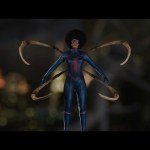How Digital Domain helped craft Wakanda Forever’s ship attack.
The biggest sequence in Ryan Coogler’s Black Panther: Wakanda Forever takes place on the Atlantic Ocean, where the Wakandans lure the Talokanil to their vessel hoping to disable their king, Namor, and where a major battle ensues.
Of course, production was never going to consider shooting that on the open water. That’s where visual effects came in.
The battle was staged with actors and stunt performers on bluescreen and ‘negative fill’ sets in Atlanta, with a partial ship deck. Digital Domain, working with production visual effects supervisor Geoffrey Baumann, was then principally responsible for fleshing out the scenes, compositing the live-action warriors into the shots, producing extra ones where needed, adding in the full ship, and realising digital water.
Wait. Blue characters on bluescreen?
The Talokanil are blue-skinned characters, at least on dry land (underwater, they have natural skin tones). So, did this present any significant challenges in placing them into the battle scenes despite being shot on bluescreen? Digital Domain visual effects supervisor Hanzhi Tang says no more than usual, in the VFX world.
“Luckily their painted-on skin tone was quite a very light shade of blue. Against the bluescreen it’s still something that we can rotoscope. We were already planning on a lot of rotoscope work anyway, because of the amount of fixes that needed to be done. We had to place their rebreathers on their faces and necks, which all needed to be tracked and roto-mated. Also, the stunt performers had to wear shoes for safety, which also needed to be painted out or removed.”
Digital Domain would also effectively be replacing the deck surface in many shots, necessitating roto. The 60-feet long by 75-feet wide deck piece had been built 20 feet up in the air, and constructed to hinge at almost 45 degrees. “Everyone could slide off when the boat sank,” notes Tang. “It made it a very complicated shoot, along with all the safety rigging. There was a lot of brute force prep work that needed to be done.”

“Then,” he adds, “the Talokanil are climbing up a hundred foot wall that was flat. We had to try and hide the handholds and things and make it into the curved hull of the boat, and get it all to line up. Just replacing all that with the CG boat and ship–there was a lot of difficult comp work in that whole sequence.”
Digi-double take-overs
The high-intensity battle saw stunt performers create incredible scenes on wire rigs and crash mats. For more impossible moves or camera angles, Digital Domain orchestrated CG take-overs of Wakandan and Talokanil warriors, starting with Clear Angle scans.

“We used those scans to build around 115 digital double assets, either of the hero characters, mid-res or crowd size characters,” explains Tang, noting these were for other scenes in the movie, too.
To get the right behaviour for its digi-doubles, Digital Domain generally roto-mated stunt performers or actors. Namor, who can fly, would often be filmed in a tuning fork rig, necessitating replacement of various body parts to make the flying convincing.
“In some shots,” says Tang, “the actor playing Namor was just acting on a platform, or was close-up in the tuning fork, which didn’t require much work. But there’s others, including one where he grabs Shuri and flies her up into the air and he slams her back down. Those started with both actors in tuning forks, with a lot of rigging removal, and then animating digi-doubles as well.”
The VFX studio’s crowd system was used to handle large numbers of swimmers in the water and wide shots of fights towards the back of the boat. This was of course mixed with hero vignettes from the animation team.
Weapon, feather and clothing simulations were key additions to digital doubles. “I would say our cloth sim team was the unsung hero,” marvels Tang. “For example, in some of these shots we have a mixture of CG and live action characters in the shots. We’d add just a little bit of swinging on the ponytails and the loose pieces of costume to help sell it.”
Crazy water sims
For shots of fighters in the water, a 15 foot deep tank was set up next to the deck set. “That was deep enough for people to dive down, stand on a platform and then jump up and surface,” outlines Tang. “We also shot all the surface water interaction with that tank. Then we would do water extensions beyond that and blend the real water back into the CG water.”

That CG water itself was an extensive and disperate task for Digital Domain. It ranged from flat calm ocean surfaces, to splashing water full of warriors, to interactive water and wake caused by the vessel, to turbulent water caused by a sonic emitter and later the tipping of the ship, to underwater shots (parts of the underwater moments were shared with Wētā FX).
Says Tang: “I think we simulated it down to five centimetre resolution. One sim took five days! Five days! I was like, ‘I hope we don’t have to change this too often because changes will be quite difficult.’ I really liked some of the water sims that we did for this sequence.”


















